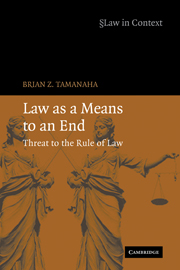Book contents
- Frontmatter
- Contents
- Acknowledgments
- Introduction
- Part 1 The spread of legal instrumentalism
- Part 2 Contemporary legal instrumentalism
- 6 Instrumentalism in legal academia in the 1970s
- 7 Instrumentalism in theories of law
- 8 Instrumentalism in the legal profession
- 9 Instrumentalism of cause litigation
- 10 Instrumentalism and the judiciary
- 11 Instrumentalism in legislation and administration
- Part 3 Corroding the rule of law
- Epilogue
- Index
- Titles in the series
9 - Instrumentalism of cause litigation
Published online by Cambridge University Press: 25 July 2009
- Frontmatter
- Contents
- Acknowledgments
- Introduction
- Part 1 The spread of legal instrumentalism
- Part 2 Contemporary legal instrumentalism
- 6 Instrumentalism in legal academia in the 1970s
- 7 Instrumentalism in theories of law
- 8 Instrumentalism in the legal profession
- 9 Instrumentalism of cause litigation
- 10 Instrumentalism and the judiciary
- 11 Instrumentalism in legislation and administration
- Part 3 Corroding the rule of law
- Epilogue
- Index
- Titles in the series
Summary
Cause litigation involves lawyers instigating legal actions to obtain decisions that further the particular agenda they support. It represents a “commitment to litigation as a tool for social change.” As one cause lawyer put it, “The law has always been an instrument of change, of course, but in recent decades it has become, through the deliberate, indeed passionate, efforts of a new breed of lawyer-activists, a favored engine of change.” “Since the early 1950s, the courts have been the most accessible and, often, the most effective instrument of government for bringing about the changes in public policy sought by social protest movements.”
The attempt to change society through court rulings is among the most ambitious forms of legal instrumentalism. It utilizes litigation in a manner that was actually prohibited a century ago. The standard paradigm of litigation envisions an unresolved dispute between parties. An injury or harm has occurred and the injured person seeks the assistance of a lawyer to obtain redress against the purported wrongdoer. Litigation is a last resort. The 1908 Canons declared firmly that “It is unprofessional for a lawyer to volunteer advice to bring a lawsuit. … Stirring up strife and litigation is not only unprofessional, but it is also indictable at common law.” Stirring up strife and litigation, then known as “barratry,” is precisely what public interest litigators do in pursuit of a cause.
- Type
- Chapter
- Information
- Law as a Means to an EndThreat to the Rule of Law, pp. 156 - 171Publisher: Cambridge University PressPrint publication year: 2006

